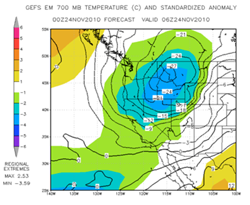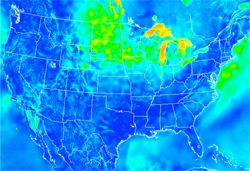
Fig. 1: |

Fig. 2: Analysis of the 10-m wind speed (m/s) at 1400 UTC 27 October 2010. |
|
Contact: John Horel
|
HMT Supports Project Focused on Advancing Analysis, Forecast and Warning Capabilities for High Impact Weather Events
MesoWest remains the cornerstone of the CSTAR project by integrating the collection, archival, and distribution of weather observations from hundreds of sources around the United States. MesoWest is used extensively for operational, research, and educational use with specific web-based tools developed for fire weather and hydrologic applications. The UU researchers coordinate with staff of the Western Region of the NWS, many Weather Forecast Offices (WFOs) around the nation, the MADIS development team at NOAA's Earth System Research Laboratory, and over eighty data providers to provide access to weather observations at over 30,000 locations. Web portals at the University and at Western Region WFOs provide access to current and restrospective weather information for operational forecasters, researchers, and the public.
NWS Student Career Employment Program (SCEP) participant and Ph.D. graduate student Trevor Alcott (NWS Student Career Employment Program (SCEP) participant and Ph.D. graduate student) collaborated with Salt Lake City WFO Science and Operations Officer Randy Graham to develop and integrate the use of standardized anomaly analyses and forecast products into operations at the Salt Lake Forecast office with these products available via the web. Using this tool, forecasters are able to assess how unusual the forecast conditions are likely to be (Fig. 1).
An efficient 2D variational system (similar to NCEP's Real Time Mesoscale analysis) developed by Ph.D. graduate student Dan Tyndall, allows researchers to examine high impact weather events. such as the 26-27 October 2010 storm that brought damaging winds and snowfall across the Great Lakes region (Fig. 2). The analysis of surface weather parameters on a continental scale of wind speed and direction, temperature is being used to examine the impact of differing data assets and analysis techniques.
A necessary step to integrate existing and future networks into a national network of networks is to assess the impact of existing mesonets. The output of the 2D variational analysis system of surface weather parameters is now being used to assess the sensitivity of the resulting Continental US-scale analyses to the available mesonet observations.